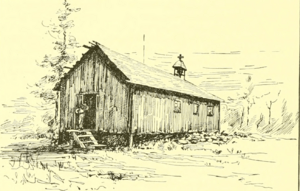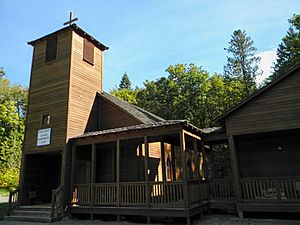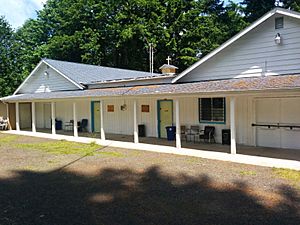Indian Shaker Church facts for kids
| Total population | |
|---|---|
| ~2000 (late 20th century) | |
| Founder | |
| John Slocum | |
| Regions with significant populations | |
| Pacific Northwest |
The Indian Shaker Church is a Christian religion started in 1881. It was founded by John Slocum, a spiritual leader from the Squaxin Island Tribe, and his wife Mary Slocum in Washington state. This church mixes ideas from Native American traditions, Catholic faith, and Protestant beliefs.
It's important not to confuse the Indian Shaker Church with other groups like the Shakers (a different religious group) or the Native American Church.
How the Church Began

The story of the Indian Shaker Church began in 1881. A man named John Slocum became very sick and seemed to die. During his wake, which is a gathering before a funeral, he woke up!
John Slocum said he had visited heaven. There, an angel told him he needed to start a new religion. A few months later, John became sick again. This time, his wife, Mary, began to shake and tremble while praying for him. Soon after, John got better. People believed Mary's shaking prayers had healed him.
This is why the religion is called the "Shaker" Church. Members often shake during their religious meetings. This shaking is believed to have healing powers.
The first church building was put up at Mud Bay. This area is near Olympia, Washington. It was close to the homes of other church founders, brothers Mud Bay Louie and Mud Bay Sam.
Beliefs and Practices

When the Indian Shaker Church first started, its members did not use the Bible or other written holy books. Instead, they believed God would speak directly to each person. They felt that understanding God's message didn't need a book. It was already in their minds and souls.
This new religion spread to many different Native American groups. These included the Klallam, Quinault, Lower Chehalis, Yakama, Hoh, Quileute, Wiyot, Yurok, and Hupa peoples.
The Indian Shaker Church combines different religious ideas:
- Catholic influences: Members use hand-held candles and ring small hand bells. They also make the sign of the cross three times.
- Protestant influences: People share their personal stories and confess their mistakes in public.
- Native American influences: They use brushing or stroking motions to remove bad influences. Members often move around the room in a circle, stomping loudly. They also receive new songs from the spirit during services.
Church members are expected to avoid alcohol and tobacco. They focus on being careful, kind, and asking God for help.
Challenges and Growth
The new Indian Shaker religion faced many problems. Some non-Native people did not understand it. They worried about an uprising, similar to what happened with the Ghost Dance. For a while, laws even banned Native American religious practices, including those of the Indian Shakers. Many members were put in prison or chained for practicing their faith.
For example, the US Indian Service once posted rules for Shaker meetings. They said meetings could only be held for a few hours on Sundays and Wednesdays. They also said windows or doors must be open. Only one bell could be used, and it couldn't ring all the time. School children were not allowed at night meetings.
There were also rules about shaking. If women shook at other times, they were told to stop. If they didn't, they could be locked up. Shaking for sick people was also not allowed.
By the late 1900s, the Indian Shaker Church had about 20 groups and 2,000 members. In the 1960s, the church split into two groups. One group, called "conservative," still did not use written religious materials. The other group, called "progressive," was more open to using the Bible and other written texts.
Today, Indian Shakers continue their practices along the Pacific Northwest coast. You can find them in Washington, Oregon, California, and British Columbia.
See also
 In Spanish: Iglesia india Shaker para niños
In Spanish: Iglesia india Shaker para niños
- List of Indian Shaker Church buildings in Washington
- New religious movement


